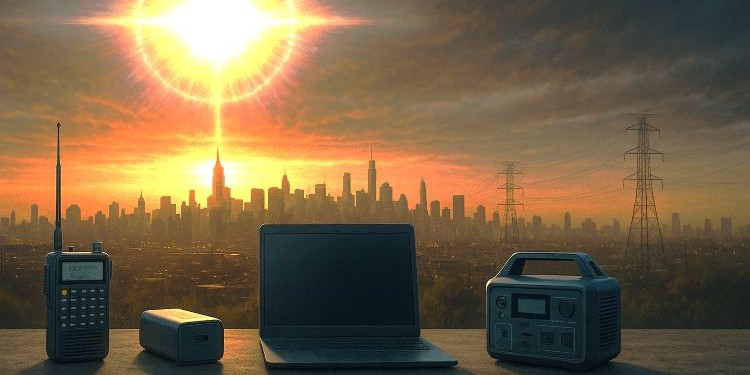Will an EMP Destroy Electronics That Are Unplugged?

Most people sleep easy thinking their gear is safe as long as it is unplugged. That their radios, generators, night vision, chargers, and backups will magically survive because they were sitting quietly on a shelf. This is the kind of dangerous comfort that gets people blindsided.
An EMP does not care whether your device is plugged in or not. It cares about how much wire, metal, and circuitry can act like an antenna. It cares about how exposed your electronics are when a wave of energy sweeps across the grid. The real threat is not the outlet. It is the invisible energy spike that attacks anything capable of receiving it.
Unplugged Does Not Mean Safe
A high altitude EMP floods the atmosphere with a fast pulse. This pulse induces voltage into anything conductive. Even a small device with internal wiring can get hit. No plug needed. If a device has a circuit, the pulse can ride right in.
Think about the tiny antenna inside your electronics. That is where the trouble starts. Phones, laptops, radios, even modern flashlights with microcontrollers. If the pulse hits them raw, the internal components can fry.
Here are examples of unplugged items that are still vulnerable:
• Portable radios sitting on a shelf
• Power banks or battery chargers not connected to anything
Simply removing the cord from the wall does nothing to stop the fundamental physics behind EMP damage.
Why Some Devices Survive and Others Fail
EMP damage depends on how sensitive the electronics are. Older tech built with bigger, tougher components might survive. Newer tech built with thin microchips does not handle sudden voltage well.
Small items with very short internal wires may get lucky. But luck is not a survival plan. The more expensive or vital the gear, the more you should assume it needs protection. A solar generator or communication rig is not something you want to gamble with.
Another factor is the overall complexity of the device. The more advanced the circuitry, the easier it is to destroy. Something simple like a basic LED flashlight might hold on during a pulse, while something like a satellite communicator could die instantly.
Here are types of gear that face the highest risk:
• Anything with a microprocessor
• Devices with long internal traces that act like antennas
If it runs on chips, it is vulnerable.
Your Home Is Not a Shield
Another popular myth says the walls of your home act like protection. Wood and drywall do nothing to stop an EMP. Even metal roofing often has gaps that let the pulse in.
If your electronics sit unprotected in a house during a major EMP, they are exposed. Unplugged or not. Some might live. Some might die. That uncertainty is exactly what makes EMP events so dangerous.
People assume that because they feel safe inside a structure, their electronics are safe too. But an EMP wave passes through buildings the same way radio signals do. It does not slow down. It does not get redirected. Your home is a container but it is not a shield.
The Only Proven Protection
A Faraday style shield is the only reliable method and the microwave oven is not a Faraday cage. You do not need a bunker. You need a container that blocks the pulse from reaching your gear. That is it. Preppers who take this threat seriously protect their equipment ahead of time. The ones who do not are betting their entire readiness on hope.
A Faraday solution works by creating a continuous conductive layer around your device. This layer forces the EMP energy to travel around the electronics instead of into them. Without that controlled barrier, the pulse follows the path of least resistance which often leads straight into your circuits.
The Prepper Mistake That Will Cost You Everything
After an EMP, you cannot simply go back to the store for a new radio or solar generator. The supply chain freezes. The grid stays dark. Communication collapses.
If your gear is dead, you are cut off from information, power, and coordination. You go from prepared to powerless in a single flash.
This is not about convenience. It is about survival. Losing your electronics means losing your ability to gather intel, generate electricity, purify water, or even coordinate with others. Preppers who underestimate this threat put their entire plan at risk.
Final Thoughts
Unplugged electronics can still be hit. Your home does not shield them. Surviving an EMP is not about gambling with physics but controlling the one factor you can. Protection.
Once you accept that EMP damage does not follow normal electrical logic, you can start preparing correctly. The sooner you shield your essentials, the fewer surprises you will face if the grid goes down for good.
Protect Your Gear Before the Pulse Hits
If there is one lesson every serious prepper learns, it is that you prepare before the disaster, not during it. That is why a lot of seasoned survivalists rely on EMP Cloth. It is a proven shielding material you can wrap around the electronics you cannot afford to lose. Radios, power banks, inverters, medical devices, solar equipment. If you want them to survive, you need real protection around them.
EMP Cloth gives you control over an unpredictable threat. It turns vulnerable electronics into shielded assets. Do not wait until the grid pops and your gear becomes silent.
Secure your essentials with reliable EMP shielding today!
You may also like:
 Is It Possible to Make Your Car EMP Proof?
Is It Possible to Make Your Car EMP Proof?
The Only 3 Shelters You’ll Need to Survive in the Wild (VIDEO)
What Would an EMP Do to the Human Body?
7 Things That Will Survive an EMP
EMP Movies That Do More Harm Than Good
Read the full article here









